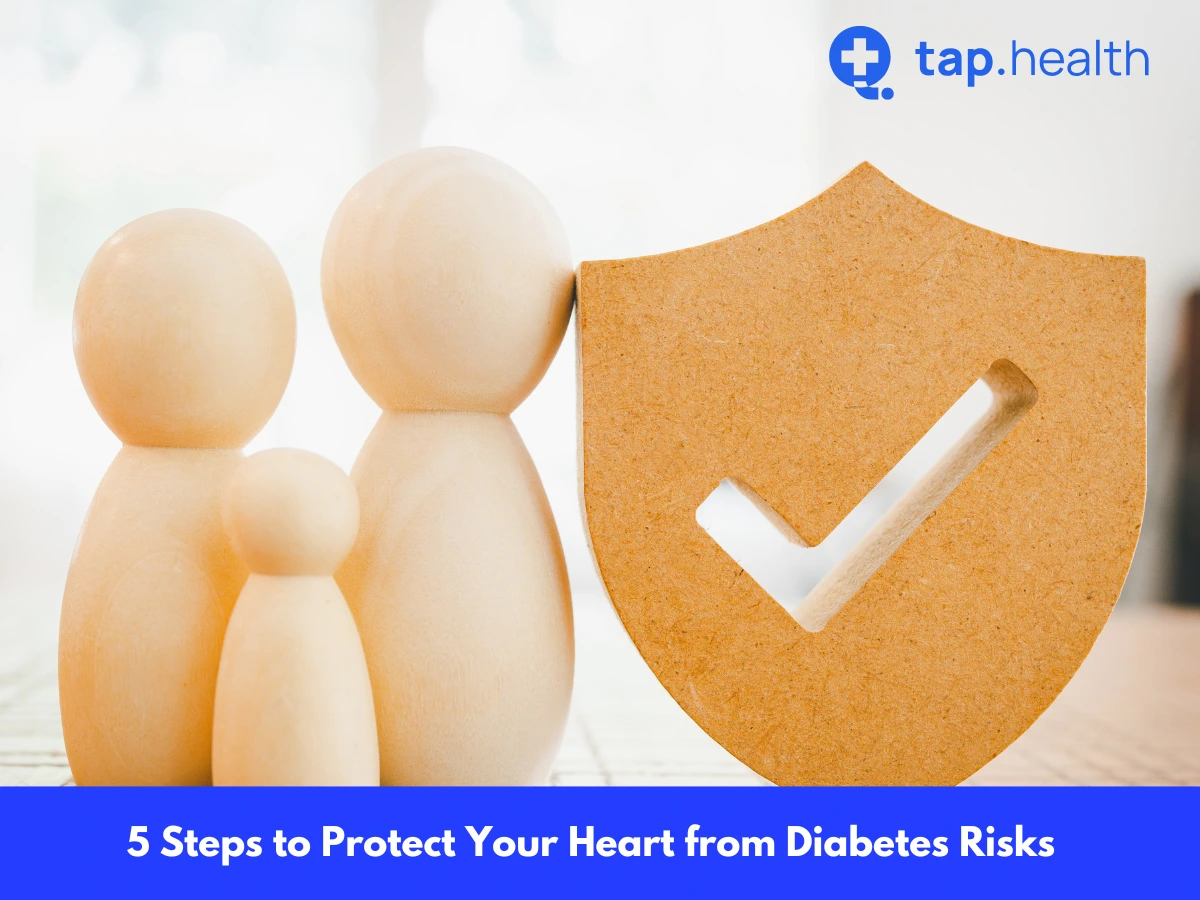Diabetes is a condition that affects how your body processes sugar (glucose). While diabetes itself is concerning, it is often the complications that arise from the condition—especially heart disease—that pose the greatest threat to your long-term health. People with diabetes are at a higher risk for cardiovascular diseases, such as heart attacks, strokes, and heart failure, because high blood sugar can damage blood vessels and nerves.
Fortunately, there are effective steps you can take to protect your heart from the risks associated with diabetes. In this article, we will explore five crucial steps to safeguard your heart health and reduce the risk of cardiovascular complications linked to diabetes. These steps are practical, easy to follow, and scientifically backed.
Why Diabetes Poses a Risk to Your Heart
People with diabetes have a higher risk of heart disease due to the effects of high blood sugar on the body. Over time, high blood sugar levels can damage the blood vessels and nerves that control the heart and blood vessels. This damage increases the chances of developing serious conditions, such as:
- Atherosclerosis (hardening of the arteries): Excess glucose in the bloodstream can lead to the buildup of fatty deposits inside the arteries, causing them to narrow. This reduces blood flow to the heart and can result in heart attacks and strokes.
- High blood pressure: Diabetes increases the likelihood of developing high blood pressure (hypertension), which puts additional strain on the heart and damages blood vessels.
- High cholesterol: Diabetes often leads to an imbalance in cholesterol levels, with an increase in LDL (bad) cholesterol and a decrease in HDL (good) cholesterol. This imbalance can further accelerate the buildup of plaque in the arteries, leading to heart disease.
Understanding these risks makes it clear why taking action to protect your heart is essential for anyone managing diabetes.
5 Steps to Protect Your Heart from Diabetes Risks
Here are five crucial steps to reduce the risk of heart disease for people with diabetes:
1. Control Your Blood Sugar Levels
Maintaining healthy blood sugar levels is the cornerstone of managing both diabetes and heart health. High blood sugar (hyperglycemia) contributes to the development of cardiovascular diseases by damaging blood vessels and increasing the risk of fatty deposits in the arteries.
How to Control Your Blood Sugar:
- Monitor your blood sugar regularly: Using a glucose meter or continuous glucose monitor (CGM), check your blood sugar levels throughout the day. Regular monitoring helps you understand how foods, physical activity, and stress affect your blood sugar.
- Eat a balanced diet: Focus on consuming foods with a low glycemic index (GI), such as whole grains, vegetables, legumes, and fruits. These foods release glucose into the bloodstream slowly, helping to maintain stable blood sugar levels. Avoid foods that cause quick spikes in blood sugar, like sugary snacks and refined carbs.
- Take prescribed medications as directed: If your doctor has prescribed diabetes medications or insulin therapy, take them exactly as instructed. Medications like metformin help control blood sugar and reduce the risk of complications, including heart disease.
- Stay consistent with your insulin therapy: For people with type 1 diabetes or insulin-dependent type 2 diabetes, insulin is a vital part of blood sugar control. Work with your healthcare provider to determine the correct dosage and administration method for optimal results.
By effectively controlling your blood sugar levels, you not only prevent the long-term damage that high blood sugar can cause to the heart but also improve your overall quality of life.
2. Maintain a Healthy Weight
Excess weight, especially around the abdomen, increases the risk of developing both diabetes and cardiovascular disease. Obesity is a known contributor to insulin resistance, high cholesterol, high blood pressure, and poor blood sugar control—all of which increase the risk of heart disease.
How to Achieve and Maintain a Healthy Weight:
- Eat smaller, more frequent meals: Eating smaller portions throughout the day helps regulate blood sugar levels and prevents overeating, which can lead to weight gain.
- Focus on portion control: Even healthy foods can contribute to weight gain if consumed in large amounts. Using smaller plates and measuring portions can help you avoid overeating.
- Exercise regularly: Regular physical activity, including both aerobic exercise (walking, cycling) and strength training, helps burn calories, build muscle, and reduce body fat. Aim for at least 30 minutes of moderate-intensity exercise most days of the week.
- Track your progress: Keep track of your weight and body measurements. Gradual weight loss is a sustainable way to improve heart health and reduce the risk of diabetes complications.
By losing excess weight and maintaining a healthy body composition, you will lower your blood sugar levels, improve cholesterol, and reduce the risk of developing heart disease.
3. Eat a Heart-Healthy Diet
What you eat directly impacts both your blood sugar levels and heart health. A heart-healthy diet that emphasizes whole, nutrient-dense foods will help control blood sugar, improve cholesterol, and lower blood pressure—all of which are crucial for protecting the heart from diabetes-related risks.
Key Components of a Heart-Healthy Diet:
- Healthy fats: Choose monounsaturated and polyunsaturated fats, such as those found in olive oil, avocados, nuts, and seeds. These fats help reduce inflammation and lower harmful LDL cholesterol.
- Fiber-rich foods: Fiber helps slow the absorption of sugar and improves blood sugar control. Include plenty of vegetables, whole grains, legumes, and fruits in your diet.
- Low-sodium foods: Excess sodium can increase blood pressure, so limit the intake of processed and packaged foods, which are often high in salt. Cook more meals at home and use herbs and spices for flavor instead of salt.
- Lean proteins: Opt for lean protein sources like chicken, turkey, fish, beans, and legumes. These proteins help stabilize blood sugar levels and support muscle growth.
- Limit refined sugars and processed foods: Avoid sugary snacks, sugary drinks, and processed foods, which contribute to rapid blood sugar spikes and increase the risk of heart disease.
By following a heart-healthy, diabetes-friendly diet, you’ll protect both your heart and your blood sugar levels, reducing the risk of complications associated with diabetes.
4. Get Active and Exercise Regularly
Exercise plays a critical role in managing both diabetes and heart health. Physical activity helps lower blood sugar by increasing the body’s sensitivity to insulin, improving cholesterol levels, and reducing blood pressure.
How Exercise Protects Your Heart and Diabetes:
- Improves insulin sensitivity: Exercise helps your muscles use glucose more efficiently, which lowers blood sugar levels and reduces the need for high insulin levels.
- Reduces blood pressure: Regular physical activity strengthens the heart and blood vessels, leading to better blood flow and lower blood pressure.
- Improves cholesterol levels: Exercise can help raise HDL (good) cholesterol while lowering LDL (bad) cholesterol, improving the overall health of your blood vessels and reducing plaque buildup.
How to Incorporate Exercise into Your Daily Routine:
- Aerobic exercise: Activities like walking, running, cycling, or swimming help improve cardiovascular health and burn calories. Aim for at least 30 minutes of moderate-intensity exercise most days of the week.
- Strength training: Incorporate weightlifting or bodyweight exercises (e.g., squats, lunges) to build muscle, boost metabolism, and improve insulin sensitivity. Aim for strength training exercises two or more times per week.
- Consistency is key: Regular exercise is essential for long-term heart and diabetes health. Start with what works for you and gradually build up your exercise routine.
Incorporating exercise into your daily life helps improve blood sugar control and reduces your risk of heart disease.
5. Manage Stress Effectively
Chronic stress can raise blood sugar levels, increase blood pressure, and contribute to heart disease. It’s essential to manage stress to protect both your heart and your diabetes control.
How Stress Affects Your Heart and Diabetes:
- Raises blood sugar: Stress triggers the release of hormones like cortisol and adrenaline, which increase blood sugar levels and can make it harder to control diabetes.
- Raises blood pressure: Stress can also increase blood pressure, which puts additional strain on the heart and blood vessels, raising the risk of heart disease.
Tips for Managing Stress:
- Practice relaxation techniques: Techniques like deep breathing, meditation, and yoga can help reduce stress and lower blood sugar.
- Set aside time for self-care: Engage in activities you enjoy, whether it’s reading, gardening, or spending time with loved ones, to help manage stress.
- Get enough sleep: Lack of sleep increases stress and negatively affects blood sugar levels. Aim for 7-9 hours of quality sleep each night.
- Social support: Spend time with family and friends who can offer emotional support and help you de-stress.
By managing stress, you’ll not only improve your heart health but also help stabilize your blood sugar levels and reduce the risk of diabetes-related complications.
FAQ on 5 Steps to Protect Your Heart from Diabetes Risks
1. Can diabetes really increase the risk of heart disease?
Yes, diabetes significantly increases the risk of heart disease. High blood sugar damages blood vessels, raises cholesterol levels, and increases the likelihood of high blood pressure—all contributing to heart disease.
2. How can I control my blood sugar to protect my heart?
Monitor your blood sugar regularly, eat a balanced and heart-healthy diet, exercise consistently, and take medications as prescribed. Proper blood sugar control reduces the risk of heart disease and other complications.
3. What foods should I avoid to protect my heart and control diabetes?
Avoid sugary foods, processed snacks, and foods high in refined carbs and saturated fats. Instead, focus on whole grains, lean proteins, healthy fats, and fiber-rich vegetables and fruits.
4. How much exercise should I do to protect my heart from diabetes risks?
Aim for at least 30 minutes of moderate exercise most days of the week. Incorporate strength training exercises two or more days per week to improve insulin sensitivity and reduce cardiovascular risks.
5. Can stress affect my blood sugar levels and heart health?
Yes, chronic stress can raise blood sugar levels and blood pressure, both of which are harmful to heart health. Managing stress through relaxation techniques and lifestyle changes is important for overall well-being.
References
- American Diabetes Association
- Mayo Clinic on Diabetes and Heart Disease
- Centers for Disease Control and Prevention (CDC) – Diabetes and Heart Disease



